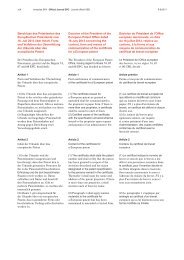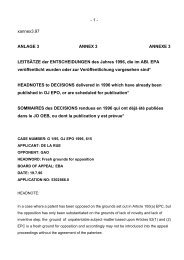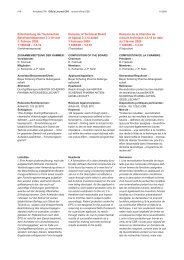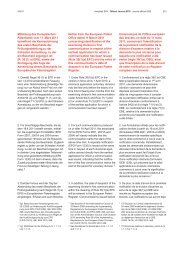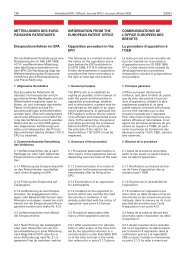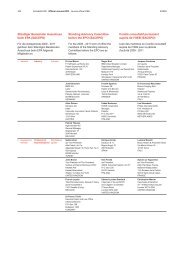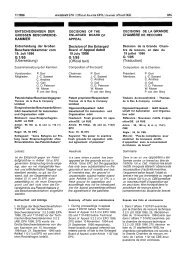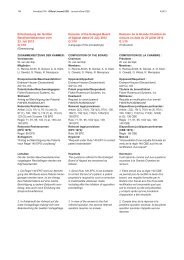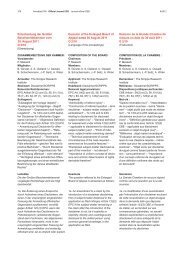Sonderausgabe 1 - European Patent Office
Sonderausgabe 1 - European Patent Office
Sonderausgabe 1 - European Patent Office
Create successful ePaper yourself
Turn your PDF publications into a flip-book with our unique Google optimized e-Paper software.
40<br />
Artikel 57<br />
Gewerbliche Anwendbarkeit<br />
<strong>Sonderausgabe</strong> Nr. 1 ABl. EPA / Special edition No. 1 OJ EPO / Edition spéciale n° 1 JO OEB<br />
Eine Erfindung gilt als gewerblich<br />
anwendbar, wenn ihr Gegenstand auf<br />
irgendeinem gewerblichen Gebiet<br />
einschließlich der Landwirtschaft<br />
hergestellt oder benutzt werden kann.<br />
Kapitel II<br />
Zur Einreichung und Erlangung des<br />
europäischen <strong>Patent</strong>s berechtigte<br />
Personen – Erfindernennung<br />
Artikel 58<br />
Recht zur Anmeldung europäischer<br />
<strong>Patent</strong>e<br />
Jede natürliche oder juristische Person<br />
und jede Gesellschaft, die nach dem für<br />
sie maßgebenden Recht einer juristischen<br />
Person gleichgestellt ist, kann die<br />
Erteilung eines europäischen <strong>Patent</strong>s<br />
beantragen.<br />
Artikel 59<br />
Mehrere Anmelder<br />
Die europäische <strong>Patent</strong>anmeldung kann<br />
auch von gemeinsamen Anmeldern oder<br />
von mehreren Anmeldern, die verschiedene<br />
Vertragsstaaten benennen, eingereicht<br />
werden.<br />
Artikel 60<br />
Recht auf das europäische <strong>Patent</strong><br />
(1) Das Recht auf das europäische<br />
<strong>Patent</strong> steht dem Erfinder oder seinem<br />
Rechtsnachfolger zu. Ist der Erfinder ein<br />
Arbeitnehmer, so bestimmt sich das<br />
Recht auf das europäische <strong>Patent</strong> nach<br />
dem Recht des Staats, in dem der<br />
Arbeitnehmer überwiegend beschäftigt<br />
ist; ist nicht festzustellen, in welchem<br />
Staat der Arbeitnehmer überwiegend<br />
beschäftigt ist, so ist das Recht des<br />
Staats anzuwenden, in dem der Arbeitgeber<br />
den Betrieb unterhält, dem der<br />
Arbeitnehmer angehört.<br />
(2) Haben mehrere eine Erfindung unabhängig<br />
voneinander gemacht, so steht<br />
das Recht auf das europäische <strong>Patent</strong><br />
demjenigen zu, dessen europäische<br />
<strong>Patent</strong>anmeldung den früheren Anmeldetag<br />
hat, sofern diese frühere Anmeldung<br />
veröffentlicht worden ist.<br />
(3) Im Verfahren vor dem Europäischen<br />
<strong>Patent</strong>amt gilt der Anmelder als berechtigt,<br />
das Recht auf das europäische<br />
<strong>Patent</strong> geltend zu machen.<br />
Article 57<br />
Industrial application<br />
An invention shall be considered as<br />
susceptible of industrial application if it<br />
can be made or used in any kind of<br />
industry, including agriculture.<br />
Chapter II<br />
Persons entitled to apply for and<br />
obtain a <strong>European</strong> patent – Mention<br />
of the inventor<br />
Article 58<br />
Entitlement to file a <strong>European</strong> patent<br />
application<br />
A <strong>European</strong> patent application may be<br />
filed by any natural or legal person, or<br />
any body equivalent to a legal person by<br />
virtue of the law governing it.<br />
Article 59<br />
Multiple applicants<br />
A <strong>European</strong> patent application may also<br />
be filed either by joint applicants or by<br />
two or more applicants designating<br />
different Contracting States.<br />
Article 60<br />
Right to a <strong>European</strong> patent<br />
(1) The right to a <strong>European</strong> patent shall<br />
belong to the inventor or his successor<br />
in title. If the inventor is an employee,<br />
the right to a <strong>European</strong> patent shall be<br />
determined in accordance with the law<br />
of the State in which the employee is<br />
mainly employed; if the State in which<br />
the employee is mainly employed cannot<br />
be determined, the law to be applied<br />
shall be that of the State in which the<br />
employer has the place of business to<br />
which the employee is attached.<br />
(2) If two or more persons have made an<br />
invention independently of each other,<br />
the right to a <strong>European</strong> patent therefor<br />
shall belong to the person whose<br />
<strong>European</strong> patent application has the<br />
earliest date of filing, provided that this<br />
first application has been published.<br />
(3) In proceedings before the <strong>European</strong><br />
<strong>Patent</strong> <strong>Office</strong>, the applicant shall be<br />
deemed to be entitled to exercise the<br />
right to a <strong>European</strong> patent.<br />
Article 57<br />
Application industrielle<br />
2007<br />
Une invention est considérée comme<br />
susceptible d’application industrielle si<br />
son objet peut être fabriqué ou utilisé<br />
dans tout genre d’industrie, y compris<br />
l’agriculture.<br />
Chapitre II<br />
Personnes habilitées à demander et<br />
à obtenir un brevet européen –<br />
Désignation de l’inventeur<br />
Article 58<br />
Habilitation à déposer une demande de<br />
brevet européen<br />
Toute personne physique ou morale et<br />
toute société assimilée à une personne<br />
morale en vertu du droit dont elle relève<br />
peut demander un brevet européen.<br />
Article 59<br />
Pluralité de demandeurs<br />
Une demande de brevet européen peut<br />
être également déposée soit par des<br />
codemandeurs, soit par plusieurs<br />
demandeurs qui désignent des Etats<br />
contractants différents.<br />
Article 60<br />
Droit au brevet européen<br />
(1) Le droit au brevet européen appartient<br />
à l’inventeur ou à son ayant cause.<br />
Si l’inventeur est un employé, le droit au<br />
brevet européen est défini selon le droit<br />
de l’Etat dans lequel l’employé exerce<br />
son activité principale ; si l’Etat dans<br />
lequel s’exerce l’activité principale ne<br />
peut être déterminé, le droit applicable<br />
est celui de l’Etat dans lequel se trouve<br />
l’établissement de l’employeur auquel<br />
l’employé est attaché.<br />
(2) Si plusieurs personnes ont réalisé<br />
l’invention indépendamment l’une de<br />
l’autre, le droit au brevet européen<br />
appartient à celle dont la demande de<br />
brevet européen a la date de dépôt la<br />
plus ancienne, sous réserve que cette<br />
première demande ait été publiée.<br />
(3) Dans la procédure devant l’<strong>Office</strong><br />
européen des brevets, le demandeur est<br />
réputé habilité à exercer le droit au<br />
brevet européen.



